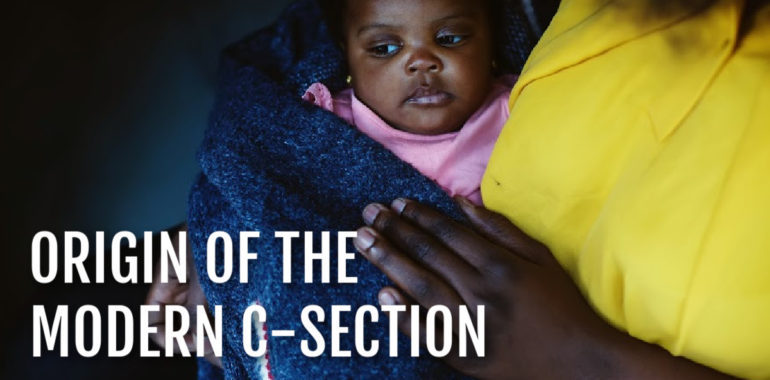By Derrick Kisita
One of the most anticipated days of the year is coming up this weekend. Mothers’ day! In the spirit of celebration, I am penning this article to highlight the roots of the modern-day C-section in honor of my mother as well as in honor of all mothers and mother figures. The purpose of this piece is strictly educational and informative, to share what I’ve learned about the origin of the modern day C-section.
A few months ago, as part of my obstetrics clinical rotation, I had the chance to scrub in and see my first Cesarean section delivery. While I stood in the operating room wide eyed and eager, I suddenly felt as if my feet were about to fall out from underneath me, and I became lightheaded as the surgeon began to yank and cut all of the abdominal layers of tissue to get to the uterus and then to the baby. In my opinion, this is most definitely one of the more intense procedures I have observed, and this is coming from someone who has witnessed a number of orthopedics and cardiothoracic procedures over the past five years. I bring this topic up because, with the advent of modern medicine, quite a few babies are being delivered via C-section. According to the World Health Organization (WHO), it is estimated that about 10%-15% of babies are brought to the world with this lifesaving surgical operation worldwide. The C-section have become all the more crucial nowadays, considering the fact that about 26% of healthy women with low-risk pregnancies and full-term babies who are positioned headfirst, and therefore typically considered equipped to deliver vaginally, end up undergoing C-sections.
When studying the origin of the modern day C-section, I was more pleased to discover that its origins were even closer to home.
Therefore, I will take a moment to briefly explore the origins of the procedure commonly used today. My initial motivation to work on this came about a couple of months ago when I was tagged in a social post. The post discussed and credited the peoples of Eastern to Central Africa for developing and near-perfecting the techniques used in modern day C-sections, hundreds of years ago. Naturally, my curiosity was piqued, and I was more pleased to discover that its origins were even closer to home. The practice is especially ascribed to the Bunyoro-Kitara kingdom in present day Western Uganda. There is also evidence that suggests that tribal midwives and medical practitioners in the tribes living around Lake Tanganyika and Lake Victoria also performed versions of the C-section. Astonishingly, the tribal surgeons in the Bunyoro-Kitara kingdom had, without doubt, perfected a method that saved both mother and child, knew when to do the operation, and had considered most facets both pre- and post-operatively.
The combination of sterile, sharp equipment and sedation made the surgical procedure surprisingly calm and comfortable for the mother.
When a baby could not be delivered vaginally, these healers sedated the laboring mother using large amounts of banana wine. They tied the mother to the bed for safety, sterilized a knife using heat, and made the incision, acting quickly as a team to prevent excessive blood loss or the accidental cutting of other organs. The combination of sterile, sharp equipment and sedation made the surgical procedure surprisingly calm and comfortable for the mother.
After the baby was delivered, antiseptic tinctures and salves were used to clean the area and stitches were applied. Women rarely developed infections or hypovolemic shock from excessive blood loss after the cesarean section. The most common problem reported was that it took longer for the mother’s milk to come in, an issue that was solved with friends and relatives who would nurse the baby instead.
The majority of women and babies survived this, and when questioned about it by European colonial officials in the mid-1900s, many people in Uganda and Tanzania indicated that the procedure had been performed routinely since time immemorial.
This was at a time when European physicians had only barely started to figure out that they should wash their hands before performing surgery. In fact, the British surgeon Joseph Lister known today for his work on surgical sterile techniques did not start spreading the word on antisepsis in London till 1877. This was also a time when nearly half of European and US women still died in childbirth, and when nearly 100% of European women died if a C-section was performed.
Detailed explanations of Ugandan C-sections were first published globally in medical scholarly journals in the 1880s after a firsthand account by physician and medical historian R. W. Felkin in 1878. He documented with emphasis on the superior efficiency of the surgeon and midwives at performing the operation, correctly inferring that the skill must have been performed and perfected through trial and error, then passed down within the tribe for several generations. Although Felkin’s recollection of this operation was initially ridiculed, questioned and disputed for its credibility all across Europe for most of his career. This meticulous and accurate recording of his observations of this surgical operation while being detained in the Bunyoro-Kitara kingdom, helped the rest of the world learn how to save mothers and babies with minimal complications. It wasn’t until the 1920s towards the end of his life that the Western medical community began to consider and take his writings seriously. Which later led to the verification and validation of his work in 1957 by another English physician and pathologist working in the then British protectorate of Uganda.
To be clear, surgical operations where mothers were cut open to save the baby when experiencing complications of labor were widely performed in various parts of the world for centuries prior to this discovery. In fact, the name Cesarean section conveniently comes from the belief that the iconic Emperor of the Roman Empire, Caesar, was delivered this way. Even though, it usually came as a last resort to cut open the mother, in the rest of the world, the sole purpose of such an operation was to save the baby and often little to no attempts were made to preserve the mother’s life after saving the baby.
This only further highlights the genius, resourcefulness, and commitment to scientific discovery of these tribal surgeons and midwives in the Bunyoro-Kitara kingdom. So, if you are one of the babes and/or mothers who wouldn’t be alive today without a C-section, you have Ugandan surgeons and Tanzanian and Congolese midwives to thank for their contributions to medical science.

